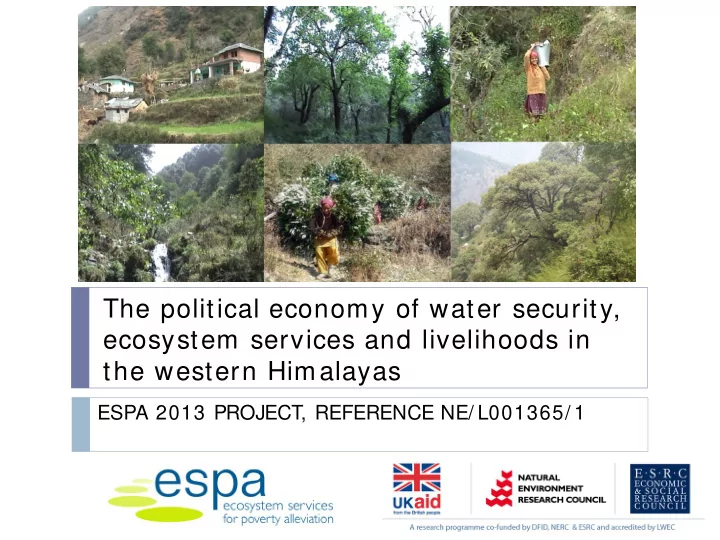

The political economy of water security, ecosystem services and livelihoods in the western Himalayas ESPA 2013 PROJECT, REFERENCE NE/ L001365/ 1
Project team University of Cambridge Bhaskar Vira Centre for Development and Research (CEDAR), India Dr Rajesh Thadani Chetan Agarwal Professor S P Singh Dr Vishal Singh Dr Devendra Chauhan Dr Ajay Saxena Southasia Institute of Advanced Studies (SIAS), Nepal Dr Hemant Ojha Dr Ngamindra Dahal Dr Kamal Devkota
Project focus: small towns Growing populations in small towns – neglected urbanisation? For every large urban settlement, estimated to be ten small towns Rapid growth, expected to double in number and size every 15 years (Pilgrim et al. 2007) Specific focus – Indian state of Himachal Pradesh and Uttarakhand, and Nepal Of the estimated 8.3 million residents in the region, 46% live in small towns (below 100,000 people) Key characteristics Continued dependence on surrounding ecosystem for water – usually surface water sources Wider relationship with natural ecosystems and surrounding catchments, despite urbanisation
Historically contested environments in the Western Himalayas Hydrological connections between the forested Himalayas and downstream communities ‘Dessicationist’ discourses of the 19 th century, to the ‘theory of Himalayan degradation’ of the mid-1970s Continued lack of detailed empirical or theoretical consensus on the forest-hydrology relationship Forests and rainfall Forests and evapo-transpiration Forests and stream flow Widespread belief in hydrological relationships Conservation of the Shimla Water Catchment since the 19 th c. Continued focus on links between Himalayan land-use change and hydrological flows in the northern/eastern plains
‘New ecologies’ of risk and vulnerability Drivers of change: dam building, deforestation, roads, pilgrim tourism, extreme weather events (climate change?) Settlement patterns along road and trade networks, spontaneous and unplanned urbanisation Demands for ecosystem services from downstream beneficiaries Human vulnerability to disaster and exposure to risk Trade-offs between ecological protection and developmental pressures
Previous ESPA-funded research (2011- 13) Palampur town, 1219 m., at the foothills of the Dhauladhar range, Himachal Pradesh ‘Small town’ – estimated population 46,224 Av. rainfall 250 cm p.a., 80% in the monsoon months (June-Aug) Dependent on the streams from upper catchments for drinking water and irrigation PES negotiated to reduce upstream pressure on infiltration zone and protect forests Post agreement political economy of access, use and control Need to understand needs and perspectives of upstream/downstream stakeholders, and recognise trade-offs
Role of landuse planning and zoning Important for securing water supplies in mountain regions, and reducing risk and vulnerability Need to understand the full range of ecosystem services in the landscape, and how these are accessed by both rural and urban stakeholders Trade-offs and choices in these contexts How is water used and allocated? Who benefits from enhanced infiltration and recharge? How is the well-being of the (rural and urban) poor impacted by changes in landuse, and improvements in aggregate water availability? What impacts are there on other ecosystem services?
Project aims To understand negotiation processes between different stakeholders (both rural and urban) over landuse and zoning strategies that influence access to water and other ecosystem services in selected catchments surrounding small towns in the Western Himalayan region; To identify the critical synergies and trade-offs associated with alternative zoning and landuse management strategies, and their likely impacts on different stakeholders; To investigate the contrasting political, governance and institutional arrangements which frame the context for these negotiations, focusing on two case studies each across three different jurisdictions – Himachal Pradesh, Uttarakhand, and Nepal; To work with local planning authorities and decision makers to explore the potential for landuse planning and zoning to address the water security needs of the region.
Specific research questions RQ1: From what sources do the selected small towns derive their water supply, and what is the current state of knowledge about the condition of these sources and threats to their sustainability? RQ2: What are the specific areas in the surrounding and source watersheds that are critical to the long term sustainability of these water supply sources (‘critical water zones’)? RQ3: What are the other ecosystem services that flow from these critical water zones, and what is the current state of knowledge about their condition and trends? RQ4: Who are the stakeholders that depend on the flows of water, and other ecosystem services, from these critical water zones, and what are their current livelihood strategies (and their poverty status)?
Specific research questions RQ5: Who are the key decision makers in these landscapes, and what are their specific institutional and resource interests in relation to flows of water, and other ecosystem services? RQ6: What are the synergies and trade-offs between (a) ecosystem services; and (b) stakeholders in these landscapes? RQ7: What is the potential for stakeholder engagement and negotiation in order to develop interventions that secure water supplies, other ecosystem services and promote sustainable livelihoods and poverty alleviation in these landscapes? RQ8: What are the implications of these findings for knowledge about the institutional and governance contexts in which ecosystem-based interventions can provide pro-poor strategies for water supply and other ecosystem services in low income (mountain) regions?
Impact and Research into Use strategy Identifying local ‘policy champions’ in case study towns and surrounding villages Engaging local stakeholders and building capacity Targeted meetings with key decision makers Flexibility – looking for windows of opportunity Working with civil society and local NGOs Use of new media to disseminate early insights, including visual/documentary/film/blogs/podcasts Academic project partners and advisory groups Close liaison with DFID South Asia Research Hub and RCUK offices in the region
Recommend
More recommend